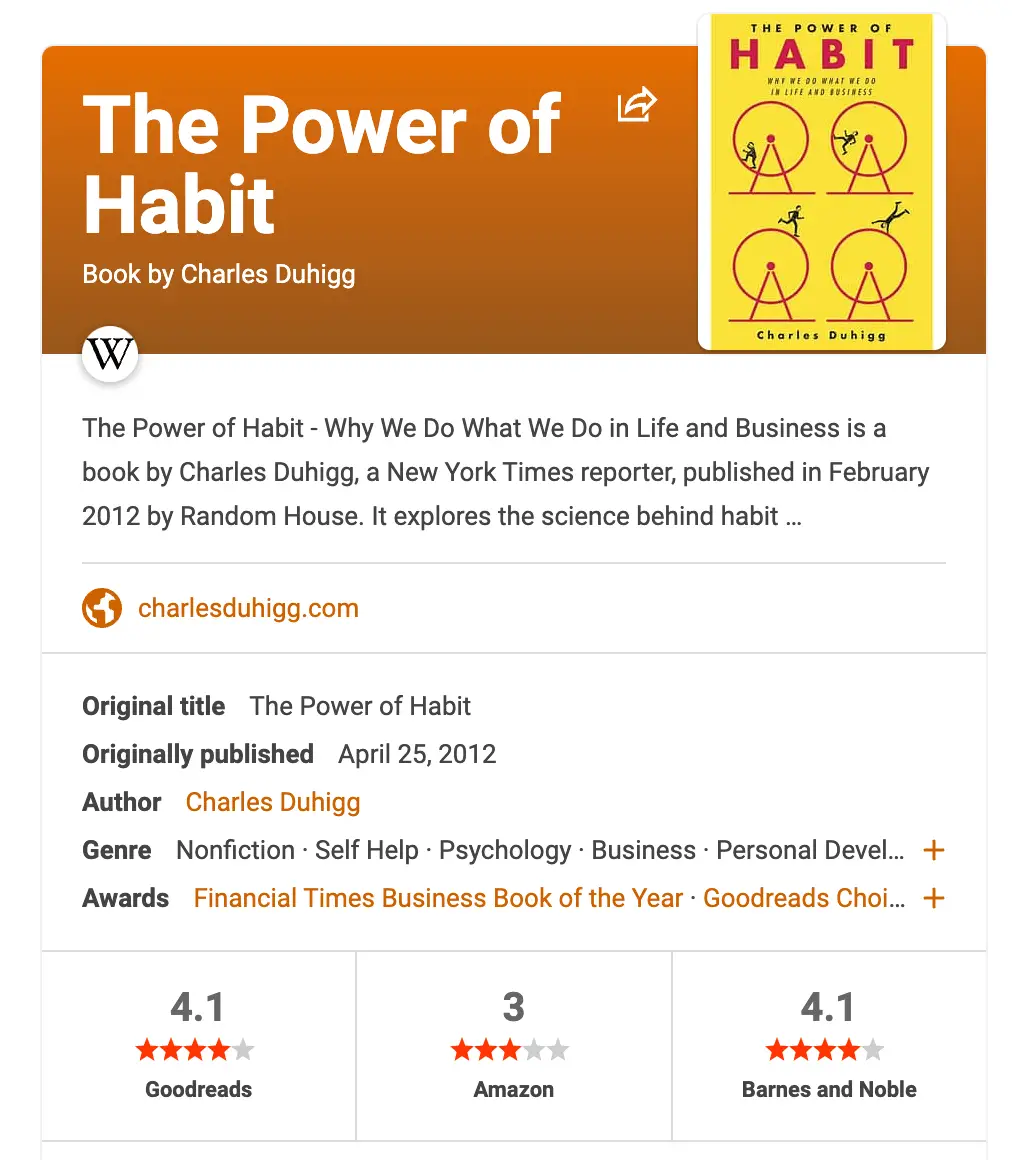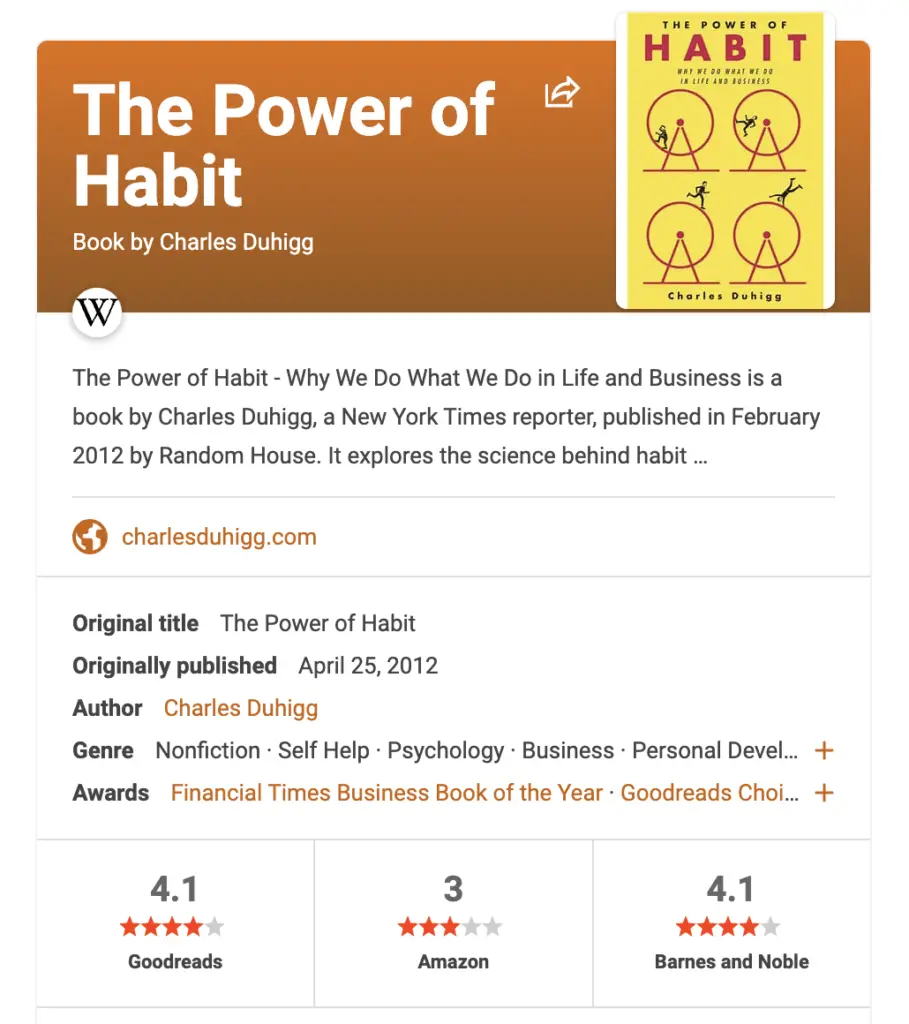Unveiling the Power of Habit: The Power of Habit Summary
Table of Contents
- 1 Unveiling the Power of Habit: The Power of Habit Summary
- 1.1 Basic Details
- 1.2 Introduction
- 1.3 The Power of Habit Book Summary
- 1.3.1 Unraveling the Habit Loop
- 1.3.2 Unlocking Keystone Habits
- 1.3.3 Unleashing the Power of Your Willpower
- 1.3.4 Revolutionizing Business with Habits
- 1.3.5 The Social Dynamics of Habits
- 1.3.6 Mastering the Art of Persuasion
- 1.3.7 Transforming Habits, Transforming Lives
- 1.3.8 The Power of Belief
- 1.3.9 Real-Life Habit Transformation Stories
- 1.3.10 Unleashing the Potential for Health
- 1.3.11 Harnessing Accountability and Support
- 1.3.12 Tracking Progress: The Key to Mastery
- 1.3.13 The Neuroscience Behind Habits
- 1.3.14 Ethical Considerations: The Power and Responsibility
- 1.3.15 Mindfulness and Habits: A Path to Self-Awareness
- 1.3.16 Navigating the Digital Landscape: Technology and Habits
- 1.3.17 Unlocking the Habits of Highly Successful Individuals
- 1.3.18 Creating Habit Loops: Your Blueprint for Success
- 1.3.19 Overcoming Common Habit Challenges
- 1.3.20 Habits and Financial Freedom
- 1.3.21 The Ripple Effect: One Habit at a Time
- 1.3.22 Habits and Happiness: The Secret to a Joyful Life
- 1.3.23 The Power of Community: Strength in Numbers
- 1.3.24 Habits and Time Management: Maximizing Your Productivity
- 1.3.25 The Power of Habit: A Personal Journey
- 1.4 Conclusion:
- 1.5 A Quick Look at “The Power of Habit”
- 1.6 A quick profile of the writer :
- 1.7 Recommendations (Other Similar Books)
- 1.8 3 reasons to read the book “The Power of Habit”:
- 1.9 Chapter-wise Summary
- 1.9.1 Chapter 1: The Habit Cure
- 1.9.2 Chapter 2: The Habit Loop: How Habits Work
- 1.9.3 Chapter 3: The Craving Brain: How to Create New Habits
- 1.9.4 Chapter 4: The Golden Rule of Habit Change: Why Transformation Occurs
- 1.9.5 Chapter 5: Keystone Habits, or The Ballad of Paul O’Neill: Which Habits Matter Most
- 1.9.6 Chapter 6: Starbucks and the Habit of Success: When Willpower Becomes Automatic
- 1.9.7 Chapter 7: The Power of a Crisis: How Leaders Create Habits Through Accident and Design
- 1.9.8 Chapter 8: How Target Knows What You Want Before You Do: When Companies Predict (and Manipulate) Habits
- 1.9.9 Chapter 9: The Habits of Societies: Saddleback Church and the Montgomery Bus Boycott: How Movements Happen
- 1.10 FAQs on “The Power of Habit”
- 1.10.1 How long does it take to form a habit?
- 1.10.2 Can I change a bad habit into a good one?
- 1.10.3 What are some common obstacles to habit change?
- 1.10.4 Are keystone habits the same for everyone?
- 1.10.5 Can habits be changed at any age?
- 1.10.6 How can I maintain the habits I’ve developed?
- 1.10.7 Is “The Power of Habit” suitable for all age groups?
- 1.10.8 How long does it take to see results from habit change?
- 1.10.9 Are there any real-life examples of individuals or organizations benefiting from the concepts in the book?
- 1.10.10 Can I use the information in this book to help my team at work?
- 1.10.11 Where can I purchase a copy of “The Power of Habit”?
Basic Details
The Power of Habit is a book by Charles Duhigg that explains the science behind habit formation and how we can change our habits.
The book is divided into three parts:
- The Habit Loop: This part of the book explains how habits work. Duhigg argues that all habits follow a three-step loop: cue, routine, and reward. The cue is a trigger that tells our brains to go into automatic mode. The routine is the behavior itself. And the reward is what our brains are seeking.
- The Golden Rule of Habit Change: This part of the book explains how to change our habits. Duhigg argues that the key to changing a habit is to keep the cue and the reward the same while changing the routine. This can be difficult, but it is possible with some effort.
- The Power of Context: This part of the book explains how our environment can influence our habits. Duhigg argues that we can change our habits by changing our environment. This means making it easier to do the things we want to do and harder to do the things we don’t want to do.
The Power of Habit is a well-researched and informative book that can help us understand our habits and how to change them. It is a valuable resource for anyone who wants to improve their life by changing their habits.
Introduction
Do you ever wonder why some people seem to effortlessly achieve success while others struggle to break free from negative patterns? The answer lies in the power of habits. Habits are the invisible forces that shape our lives, influencing everything from our daily routines to our ultimate destinies. And understanding how to harness this power can be the key to unlocking your full potential. Get ready to embark on an extraordinary journey through the pages of “The Power of Habit” by Charles Duhigg, a captivating exploration of how these seemingly mundane actions can create remarkable transformations.
The Power of Habit Book Summary
In this intriguing blogpost, we’ll take a deep dive into the world of habits as we unravel the secrets revealed in “The Power of Habit.” Be prepared to discover groundbreaking insights that will forever change the way you think about habits and how they impact your life.
Unraveling the Habit Loop
What if we told you that there’s a hidden loop governing your habits? Prepare to enter the fascinating world of the habit loop, as we uncover the three crucial elements that make up this powerful cycle: cue, routine, and reward. By understanding the inner workings of this loop, you’ll gain remarkable insights into how habits are formed and how you can harness this knowledge to transform your life.
Unlocking Keystone Habits
Imagine if making a small change in one area of your life could have a domino effect, leading to significant transformations in other areas. These are what Charles Duhigg calls keystone habits, the secret keys to unlocking extraordinary success. Discover the science behind identifying and altering these pivotal habits that can catalyze positive change throughout your life.
Unleashing the Power of Your Willpower
Do you often find yourself battling against your own impulses and desires? The science of willpower explored in “The Power of Habit” will shed light on how to strengthen your resolve and break free from destructive patterns. Learn the strategies to overcome temptation and develop unyielding willpower that will empower you to make lasting changes.
Revolutionizing Business with Habits
Habits aren’t just limited to our personal lives—they also play a pivotal role in the world of business. Get an inside look at how leading organizations have harnessed the power of habits to revolutionize their productivity, profitability, and overall success. From Silicon Valley giants to multinational corporations, the strategies shared in this section will inspire you to apply habit formation principles to your own professional endeavors.
The Social Dynamics of Habits
Did you know that our social interactions are heavily influenced by habits? Dive into the fascinating realm of social habits and discover how understanding these patterns can unlock powerful communication, improved relationships, and personal growth. You’ll be amazed by the impact seemingly small changes can have on your social interactions.
Mastering the Art of Persuasion
Ever wondered why some advertisers seem to possess a mysterious power to influence our behavior? Unveil the secrets of habit-driven marketing as we explore how businesses exploit our habits to create persuasive campaigns and foster brand loyalty. Gain insights into the psychology of consumer behavior and learn how to protect yourself from manipulative marketing tactics.
Transforming Habits, Transforming Lives
Are you ready to break free from bad habits and embrace positive change? Duhigg offers practical guidance on how to initiate and sustain habit transformations effectively. From building new habits to eradicating old ones, this section is packed with proven strategies that will empower you to create the life you’ve always dreamed of.
The Power of Belief
Believe it or not, belief plays a vital role in habit formation. Cultivating a growth mindset and seizing the power of belief can be the catalyst for remarkable transformations. Learn how to overcome self-doubt, build confidence, and take charge of your habits and your life.
Real-Life Habit Transformation Stories
Nothing inspires like real-life success stories. Dive into the true accounts of individuals and organizations that have experienced profound transformations through the power of habits. These gripping tales serve as a testament to the potential that lies within each and every one of us, fueling your own journey of habit change with hope and motivation.
Unleashing the Potential for Health
Are your habits supporting your health and well-being? Discover how the habits we cultivate impact our physical and mental health. Gain valuable insights into how modifying your habits can lead to a healthier lifestyle, increased energy, and overall well-being.
Harnessing Accountability and Support
Accountability and support systems are vital for habit formation. Explore the role of community, mentors, and friends in your habit transformation journey. Learn valuable techniques for establishing accountability, creating a supportive environment, and setting yourself up for success.
Tracking Progress: The Key to Mastery
Tracking your habits is essential for long-lasting change. In this section, we’ll delve into powerful methods and tools for monitoring your progress, staying motivated, and celebrating milestones along the way. Supercharge your habit transformation by keeping a close eye on your journey.
The Neuroscience Behind Habits
For curious minds, this section offers a captivating exploration of the neuroscience behind habit formation. Delve into the intricate workings of the brain and discover how to manipulate these neurological processes to your advantage. Expand your knowledge and gain a deeper understanding of the science behind the power of habits.
Ethical Considerations: The Power and Responsibility
With great power comes great responsibility. Reflect on the ethical aspects of habit manipulation and the impact it can have on others. Gain a deeper understanding of the potential consequences of wielding the power of habits and be equipped to navigate the ethical dilemmas that arise.
Mindfulness and Habits: A Path to Self-Awareness
Mindfulness practices can complement your habit transformation efforts, improving self-awareness and helping you align your actions with your values. Discover the synergistic relationship between mindfulness and habits, and unlock the path to a more conscious and intentional way of living.
In today’s tech-driven world, our habits are increasingly influenced by cutting-edge technologies. Explore the impact of habit-forming technologies and learn how to use them mindfully. Uncover techniques to regain control over your digital habits and foster a healthier relationship with technology.
Unlocking the Habits of Highly Successful Individuals
Success leaves clues, and habits play a pivotal role in the journeys of the most accomplished individuals. Unveil the habits of highly successful people and discover how you can emulate their strategies to achieve your own goals. Learn from their triumphs and integrate their habits into your life.
Creating Habit Loops: Your Blueprint for Success
Building new habits is no easy feat, but with the right guidance, it can become second nature. In this section, we provide you with a step-by-step guide on creating effective habit loops that will pave the way for lasting change. Equip yourself with the tools and strategies you need to succeed on your habit transformation journey.
Overcoming Common Habit Challenges
Changing habits isn’t always smooth sailing. Obstacles may arise, and self-doubt may creep in. Rest assured, we’ve got you covered. Discover effective strategies for overcoming common challenges in habit formation and learn how to navigate setbacks and persevere in your journey towards lasting change.
Habits and Financial Freedom
Financial habits can make or break your financial well-being. Explore the impact of habits on your financial success and discover practical tips for improving your financial habits. Unlock the path to financial freedom as you develop smart money habits that will secure your future.
The Ripple Effect: One Habit at a Time
Did you know that changing one habit can create a ripple effect throughout your entire life? In this exciting section, we explore the transformative power of habit change and how it can lead to positive shifts in other areas. Witness the magic of cascading change as you embark on your journey towards a better version of yourself.
Habits and Happiness: The Secret to a Joyful Life
Happiness is an inside job, and habits play a crucial role in our overall well-being. Discover how cultivating positive habits can enrich your life with joy, fulfillment, and a sense of purpose. Explore the scientific link between habits and happiness and unlock the key to a more satisfying and rewarding existence.
The Power of Community: Strength in Numbers
There’s strength in numbers, and leveraging the power of community can amplify your habit transformation journey. Find out how joining or creating a supportive community can provide the accountability, encouragement, and inspiration you need to make lasting changes. Experience the transformative benefits of a like-minded tribe.
Habits and Time Management: Maximizing Your Productivity
Do you often find yourself struggling to manage your time effectively? Effective habit formation can be a game-changer when it comes to time management. Discover how the right habits can supercharge your productivity, helping you make the most of every precious moment.
The Power of Habit: A Personal Journey
In this section, we will share a personal journey of applying the principles from “The Power of Habit” and the transformative impact it had on our lives.
Conclusion:
Unleash Your Habit Superpowers Congratulations! You’ve now completed an extraordinary journey through the transformative insights presented in “The Power of Habit.” Armed with this newfound knowledge, you possess the tools to unleash your habit superpowers and create the life you’ve always envisioned. Embrace the power of habits, and let your extraordinary potential unfold.
A Quick Look at “The Power of Habit”
- Title: “The Power of Habit”
- Written by: Charles Duhigg (New York Times reporter)
- Publication: 2012
- Length: 371 pages, 104,000 words (paperback edition)
- Genre: Non-fiction
- Focus: Explores habit formation and how to change habits
- Languages: Translated into over 40 languages
- Notable Aspects:
- Bestseller on The New York Times, Amazon.com, and USA Today
- Praised for clear writing, insights into habit science, and practical advice
- Awards: Pulitzer Prize for Explanatory Reporting winner
- Divided into three parts:
- Habit Loop,
- Golden Rule of Habit Change,
- Power of Context
- Here is a breakdown of the chapters:
- The Habit Cure
- The Habit Loop: How Habits Work
- The Craving Brain: How to Create New Habits
- The Golden Rule of Habit Change: Why Transformation Occurs
- Keystone Habits, or The Ballad of Paul O’Neill: Which Habits Matter Most
- Starbucks and the Habit of Success: When Willpower Becomes Automatic
- The Power of a Crisis: How Leaders Create Habits Through Accident and Design
- How Target Knows What You Want Before You Do: When Companies Predict (and Manipulate) Habits
- The Habits of Societies: Saddleback Church and the Montgomery Bus Boycott: How Movements Happen
A quick profile of the writer :
Profile: Charles Duhigg
- Background:
- American journalist and non-fiction author
- Born in 1974 in New Mexico
- Notable Books:
- “The Power of Habit: Why We Do What We Do in Life and Business” (2012)
- “Smarter Faster Better” (2016)
- Editorial Role:
- Former reporter for The New York Times
- Currently writes for The New Yorker Magazine
- Education:
- Yale University graduate
- Master of Business Administration (MBA) from Harvard Business School
- Writing Impact:
- Explores topics of habits, productivity, and the science of the brain
- Recognition:
- Pulitzer Prize for Explanatory Reporting (2013)
- New York Times Bestseller (The Power of Habit)
- A frequent speaker on habits, productivity, and the brain’s science
- Appeared on shows – The Today Show, Good Morning America, & NPR’s Fresh Air.
- Personal:
- Married with two children
- Resides in New York City
- Legacy:
- Duhigg’s legacy includes influential books and impactful speaking engagements.
- Work published in:
- The New York Times and The New Yorker Magazine.
Recommendations (Other Similar Books)
- “Smarter Faster Better” by Charles Duhigg
- “Atomic Habits” by James Clear
- “Daring Greatly” by Brené Brown
- “The 7 Habits of Highly Effective People” by Stephen R. Covey
3 reasons to read the book “The Power of Habit”:
Sure, here are 3 reasons to read the book “The Power of Habit”:
- It will help you understand how habits work. The book explains the science behind habit formation and how we can change our habits. This knowledge can be helpful for anyone who wants to make changes in their life, whether it’s losing weight, getting organized, or becoming more productive.
- It will give you practical advice on how to change your habits. The book provides a step-by-step guide on how to change your habits. This advice is based on the latest research in habit formation and is backed by real-life examples.
- It will inspire you to change your habits. The book is full of inspiring stories of people who have changed their habits and transformed their lives. These stories can give you the motivation you need to make changes in your own life.
Chapter-wise Summary
Sure, here is a more detailed summary of the book “The Power of Habit” by Charles Duhigg:
Chapter 1: The Habit Cure
This chapter introduces the concept of the habit loop, which is a three-step process that explains how habits work. The first step is the cue, which is a trigger that tells our brains to go into automatic mode. The second step is the routine, which is the behavior itself. And the third step is the reward, which is what our brains are seeking.
For example, the cue for going for a run might be seeing your running shoes by the door. The routine is putting on your shoes and going for a run. And the reward is the feeling of accomplishment and well-being you get from running.
Chapter 2: The Habit Loop: How Habits Work
This chapter goes into more detail about the habit loop. Duhigg explains how habits are formed and how they can be changed. He also discusses the role of willpower in habit formation.
Duhigg explains that habits are formed when our brains create a neurological pathway between the cue and the routine. The more we repeat this pathway, the stronger it becomes. Eventually, the cue becomes so strong that it automatically triggers the routine, even without our conscious awareness.
Willpower is a limited resource. It can be used to resist temptation or to start a new habit, but it can also be depleted. When we are low on willpower, we are more likely to give in to temptation or to revert to old habits.
Chapter 3: The Craving Brain: How to Create New Habits
This chapter focuses on how to create new habits. Duhigg explains how to identify our cravings and how to use them to our advantage. He also discusses the importance of making small changes and gradually building new habits.
Duhigg explains that our brains are wired to crave novelty and rewards. This is why it can be so difficult to break bad habits. However, we can use our cravings to our advantage by identifying the things we crave and then finding healthy ways to satisfy those cravings.
For example, if you crave chocolate, you could try eating a piece of fruit instead. Or, if you crave social interaction, you could join a club or volunteer your time.
Chapter 4: The Golden Rule of Habit Change: Why Transformation Occurs
This chapter discusses the Golden Rule of Habit Change, which is to keep the cue and the reward the same while changing the routine. Duhigg explains how this can be done and provides some practical tips for changing habits.
The Golden Rule of Habit Change is based on the idea that the cue and the reward are the most important parts of the habit loop. If we can keep these two things the same, while changing the routine, we can change the habit without having to fight our cravings.
For example, if you want to break the habit of smoking, you could try keeping the cue (the urge to smoke) the same, but changing the routine (instead of smoking, you could take a few deep breaths or go for a walk).
Chapter 5: Keystone Habits, or The Ballad of Paul O’Neill: Which Habits Matter Most
This chapter introduces the concept of keystone habits, which are habits that can have a ripple effect on other areas of our lives. Duhigg discusses the story of Paul O’Neill, who was the CEO of Alcoa. O’Neill believed that keystone habits, such as safety and quality, could transform an entire company.
Keystone habits are habits that have a big impact on our lives. They can make us more productive, more organized, and more successful. When we change a keystone habit, it can lead to changes in other areas of our lives.
Chapter 6: Starbucks and the Habit of Success: When Willpower Becomes Automatic
This chapter tells the story of Starbucks and how the company created a habit of success. Duhigg explains how Starbucks used the habit loop to create a culture of customer service and employee satisfaction.
Starbucks is a company that is known for its excellent customer service. Duhigg explains that this is due in part to the company’s focus on creating keystone habits, such as greeting customers with a smile and making eye contact.
Chapter 7: The Power of a Crisis: How Leaders Create Habits Through Accident and Design
This chapter discusses how leaders can create habits through accident and design. Duhigg explains how leaders can use crises to their advantage and how they can design habits that will help their organizations succeed.
Crises can be a powerful force for change. They can force us to rethink our habits and create new ones. Leaders can use crises to their advantage by creating new habits that will help their organizations survive and thrive.
Chapter 8: How Target Knows What You Want Before You Do: When Companies Predict (and Manipulate) Habits
In this chapter, Duhigg discusses how companies can use our habits to their advantage. He explains how companies like Target use data to predict our habits and how they can use this information to sell us more products.
Duhigg tells the story of a woman who was surprised to receive coupons in the mail for baby products. She was not pregnant, but Target had predicted that she was likely to become pregnant based on her purchase history.
Duhigg argues that companies like Target are not just predicting our habits, they are also manipulating them. They are creating new habits for us by making it easier for us to buy the things we want.
Chapter 9: The Habits of Societies: Saddleback Church and the Montgomery Bus Boycott: How Movements Happen
In this chapter, Duhigg discusses how habits can be used to create social change. He tells the stories of Saddleback Church and the Montgomery Bus Boycott, which are two examples of how habits can be used to bring about positive change.
Saddleback Church is a megachurch in California that has been successful in part because of its focus on creating keystone habits.
For example, the church has a habit of starting each service with a time of singing and prayer. This habit helps to create a sense of community and belonging among the congregation.
The Montgomery Bus Boycott was a successful campaign to end segregation on public buses in Montgomery, Alabama. The boycott was organized by a group of women called the Women’s Political Council. The women used the habit loop to their advantage by creating a new routine: boycotting the buses.
Duhigg argues that habits can be a powerful force for change. They can be used to create positive change in our own lives and in the world around us.
FAQs on “The Power of Habit”
How long does it take to form a habit?
The time it takes to form a habit can vary from person to person and depending on the complexity of the habit. On average, it takes about 66 days to establish a new habit, according to research.
Can I change a bad habit into a good one?
Yes, it is possible to change a bad habit into a good one. The key lies in understanding the habit loop and using strategies like identifying triggers and replacing the routine with a healthier one.
What are some common obstacles to habit change?
Common obstacles to habit change include lack of motivation, inconsistency, and external triggers. Overcoming these challenges requires determination, accountability, and a supportive environment.
Are keystone habits the same for everyone?
No, keystone habits can vary from person to person. What constitutes a keystone habit depends on individual goals and circumstances.
Can habits be changed at any age?
Yes, habits can be changed at any age. Neuroplasticity allows the brain to adapt and form new neural pathways throughout life, making habit change possible at any stage.
How can I maintain the habits I’ve developed?
Maintaining habits requires ongoing effort and consistency. Creating a habit loop with a satisfying reward, staying accountable, and tracking your progress are effective ways to ensure habit longevity.
Is “The Power of Habit” suitable for all age groups?
Yes, the book’s principles can be applied by individuals of all ages, from teenagers to seniors.
How long does it take to see results from habit change?
The timeline for habit change varies from person to person, but with consistent effort, positive results can be achieved in a matter of weeks or months.
Are there any real-life examples of individuals or organizations benefiting from the concepts in the book?
Yes, the book provides numerous case studies and examples of individuals and organizations that have successfully applied these principles.
Can I use the information in this book to help my team at work?
Absolutely, the principles discussed in the book can be applied in a professional setting to boost productivity and team performance.
Where can I purchase a copy of “The Power of Habit”?
You can find the book at most major bookstores, and online retailers, or access it through your local library.
- Buy this book from Amazon here
- Read Gung Ho Book Summary: Here




